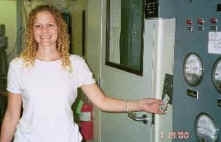
School:
Grade Level:
Teaching Position:
Supervisor:
Department:
Mentor:
Research Project Year:
Research Project Title:
Research Project Description:
Gallium nitride (GaN) is a wide band gap, compound semiconductor material. Like other semiconductor materials, GaN can be used to make electronic and optoelectronic devices such as diodes, transistors, light emitting diodes (LEDs), and lasers. In order to make devices GaN is patterned using microprocessing techniques such as deposition, lithography, and etching. Unlike other semiconductor materials such silicon (Si) or gallium arsenide (GaAs) used widely in industry, GaN is an extremely physically hard and chemically stable material. Conventional wet etching or liquid-chemical-based etching methods are relatively ineffective on GaN. Dry etching techniques, which combine a chemical component and a physical component, must be used. In general, the chemical component is a highly reactive gaseous chemical and the physical component is some form of high energy ion bombardment. The two components work cooperatively to remove material at an acceptable rate.
A disadvantage of dry etching is that ion bombardment creates damages the ordered structure of GaN. When high energy ions impinge on the GaN surface, they can knock the ordered GaN atoms out of place or lodge themselves between the GaN atoms. The ordered structure is damaged. The disorder created can adversely affect device performance. Because GaN technology is still developing, knowledge and understanding of etch damage in GaN is minimal. The RET project will focus on increasing the current knowledge of etch induced damage in GaN. The effects of etching parameters such as chemical/physical components ratio, ion energy, and ion current density will be investigated. Scanning electron microscopy, atomic force microscopy, and profilometry will be used to characterize the etch rate, etch profile, and surface damage of GaN under various etch conditions.
Curriculum Project Year:
Curriculum Project Title:
Curriculum Project Description:
Lab reports and presentations can be powerful assessment tools for the teacher. However, the benefits in asking your students to communicate go beyond assessment. Learn how to use different modes of communication between students to increase their communication skills and help them develop understanding of scientific concepts, all while creating a scientific community.
Curriculum Project Attachments:
| Attachment | Size |
|---|---|
| 188.5 KB |
